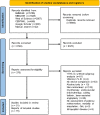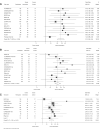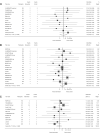Endovascular revascularization strategies for aortoiliac and femoropopliteal artery disease: a meta-analysis
- PMID: 36721954
- PMCID: PMC10011342
- DOI: 10.1093/eurheartj/ehac722
Endovascular revascularization strategies for aortoiliac and femoropopliteal artery disease: a meta-analysis
Abstract
Aims: Optimal endovascular management of intermittent claudication (IC) remains disputed. This systematic review and meta-analysis compares efficacy and safety outcomes for balloon angioplasty (BA), bare-metal stents (BMS), drug-coated balloons (DCB), drug-eluting stents (DES), covered stents, and atherectomy.
Methods and results: Electronic databases were searched for randomized, controlled trials (RCT) from inception through November 2021. Efficacy outcomes were primary patency, target-lesion revascularization (TLR), and quality-of-life (QoL). Safety endpoints were all-cause mortality and major amputation. Outcomes were evaluated at short-term (<1 year), mid-term (1-2 years), and long-term (≥2 years) follow-up. The study was registered on PROSPERO (CRD42021292639). Fifty-one RCTs enrolling 8430 patients/lesions were included. In femoropopliteal disease of low-to-intermediate complexity, DCBs were associated with higher likelihood of primary patency [short-term: odds ratio (OR) 3.21, 95% confidence interval (CI) 2.44-4.24; long-term: OR 2.47, 95% CI 1.93-3.16], lower TLR (short-term: OR 0.33, 95% CI 0.22-0.49; long-term: OR 0.42, 95% CI 0.29-0.60) and similar all-cause mortality risk, compared with BA. Primary stenting using BMS was associated with improved short-to-mid-term patency and TLR, but similar long-term efficacy compared with provisional stenting. Mid-term patency (OR 1.64, 95% CI 0.89-3.03) and TLR (OR 0.50, 95% CI 0.22-1.11) estimates were comparable for DES vs. BMS. Atherectomy, used independently or adjunctively, was not associated with efficacy benefits compared with drug-coated and uncoated angioplasty, or stenting approaches. Paucity and heterogeneity of data precluded pooled analysis for aortoiliac disease and QoL endpoints.
Conclusion: Certain devices may provide benefits in femoropopliteal disease, but comparative data in aortoiliac arteries is lacking. Gaps in evidence quantity and quality impede identification of the optimal endovascular approach to IC.
Keywords: Atherectomy; Drug-coated balloon; Drug-eluting stent; Endovascular revascularization; Intermittent claudication; angioplasty.
© The Author(s) 2023. Published by Oxford University Press on behalf of the European Society of Cardiology.
Conflict of interest statement
Conflict of interest: D.K., T.M., Z.S., S.B., A.C.Q.C, C.A.B., F.K., C.N., and A.L. declare that there is no conflict of interest.
Figures








Comment in
-
Endovascular therapies for aorto-iliac and femoro-popliteal arterial disease: Buridan's ass and the journey towards patient-tailored plaque therapy (PTPT).Eur Heart J. 2023 Mar 14;44(11):951-953. doi: 10.1093/eurheartj/ehac796. Eur Heart J. 2023. PMID: 36721970 No abstract available.
References
-
- Behrendt CA, Sedrakyan A, Peters F, Kreutzburg T, Schermerhorn M, Bertges DJ, et al. . Editor’’s choice - long term survival after femoropopliteal artery revascularisation with paclitaxel coated devices: a propensity score matched cohort analysis. Eur J Vasc Endovasc Surg 2020;59:587–596. 10.1016/j.ejvs.2019.12.034 - DOI - PubMed
-
- Antonopoulos CN, Mylonas SN, Moulakakis KG, Sergentanis TN, Sfyroeras GS, Lazaris AM, et al. . A network meta-analysis of randomized controlled trials comparing treatment modalities for de novo superficial femoral artery occlusive lesions. J Vasc Surg 2017;65:234–245.e211. 10.1016/j.jvs.2016.08.095 - DOI - PubMed
-
- Caradu C, Lakhlifi E, Colacchio EC, Midy D, Bérard X, Poirier M, et al. . Systematic review and updated meta-analysis of the use of drug-coated balloon angioplasty versus plain old balloon angioplasty for femoropopliteal arterial disease. J Vasc Surg 2019;70:981–995.e910. 10.1016/j.jvs.2019.01.080 - DOI - PubMed

